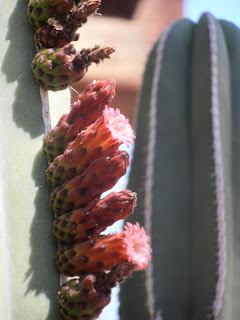Saguaro cacti usually bloom mid- to late-May, but with the early heat (105 F two days ago) flowers are already opening.
These pictures were taken less than a week apart.
And the next day:
Flowers open in the evening, and are gone with the heat of the following day. Bees are good pollinators, but bats are the main pollinators. Before I got to take this shot, a hummingbird was buzzing one of the flowers.
As long as the topic is saguaros, I'll show one that is dying:
Although there is green which indicates chlorophyl and production of food and therefore life, this saguaro is very near death.
The lower portion is oozing out black rot. The saguaro will likely die this summer.
Saguaros can be extremely tough, too. This one has endured being chopped, shot and who knows what else.
Same saguaro as above, shown here producing lots of flowers.
Here's the whole cactus:



.JPG)
.JPG)
.JPG)









.JPG)
































